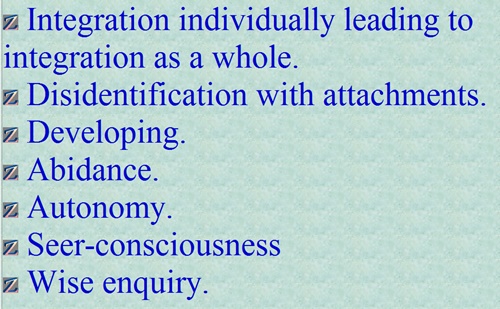This third part is very much a journey into the unknown. In the first part zandtao looked at Stephen and his apparent attempt to make the 4NT a secular practice for Buddhists – he could have been looking at more than that. For zandtao this z-quest on the secular led to the 7 core components of practice but he notes that these components are more an inclusive guide rather than a practice in themselves:-

The meaning of inclusivity in your practice that zandtao is asking for - are these components within the practice your elder/institution has advised? For zandtao it was the elder Buddhadasa and the institution of Buddhism that had helped him develop his practice. And in terms of these components his practice appeared sound.
But in searching for the secular in Buddhism with Stephen zandtao recognised the importance of autonomy, and this autonomy brings into question any impositions from an institution. Zandtao’s autonomy needs to be free from institutional impositions.
Together with coming across the feminine way of Nicola Amadora this examination of the secular path brought out something that was lacking in his practice – emphasis on love immanence and embodiment. In the second part of culture of awakening the consideration of what was secular together with the feminine way questioned the balance of his practice, and highlighted the importance of the mindfulness/sati, love/karuna, wisdom/panna, concentration/samadhi and embodiment/sampajanna - for zandtao these Dhamma comrades include love/karuna.
This has led to changes within his zandtao prajna autonomous practice but has also changed the overall structure of his practice. This structural change has involved guided meditations concerning love and embodiment, and as yet zandtao is not clear whether these are transitional practices concerning rebalancing love and wisdom. Or maybe daily now means MwB and a guided meditation on love and embodiment?
This lack of emphasis on love is clearly because love and patriarchy are inherently in conflict. Wisdom can compromise with patriarchy, and teaching/religious institutions can exist within patriarchy in order to protect the teachings and ensure that wisdom survives. But love cannot compromise with patriarchy, and love demands an end of the destructions within patriarchy. The institutions have always been uneasy with patriarchy but emphasis on wisdom allows for an uneasy alliance. For zandtao love necessitates the end of patriarchy so much so that he cannot associate with the institution that has taught him because of their compromise. Love has to call for the end of patriarchy through seekers following their paths – through seekers changing their emphasis to include a love-wisdom balance – a prajna balance.
This autonomous move away from the institution that has helped him follow his path leaves much that is open. How much have the teachings been compromised by the institution’s alliance? For zandtao there are two significant changes he is now following. The first is that he is changing the 4 Dhamma comrades to 5 Dhamma comrades – mindfulness/sati, samadhi/concentration, and wisdom/panna. He now adds spiritual love, and these four are brought together in daily life with sampajanna/embodiment.
The second is the phrase that arose from studying the suttas (App B) at the beginning of this z-quest, the phrase that led to his component of seer consciousness – knowing and seeing what is – tathata. Why is this not feeling, knowing and seeing what is – tathata. Seer consciousness is concerned with the three of love - feeling, wisdom - knowing and tathata -seeing.
Just these two changes show that the teachings have been compromised, it is not a question of whether the Theravada institution has been compromised but how much? Zandtao has always been on the periphery of Buddhism, his practice involved the study of Buddhism’s great teachers but did not involve institutional rites and rituals; nor was he ever a monastic although he has always been grateful for the retreats at
Harnham. Of course a more gross aspect of Theravada’s compromise was the Bhikkhuni ordination of 2009, a patriarchal sore that still blights the institution. Clearly institutional practice has been limited by their compromise with patriarchy but how much have the teachings been in error? Undoubtedly there have been errors in the love-wisdom balance.
So zandtao has to question two aspects of his practice:-
 How much has he and his teaching as zandtaomed been compromised by the teachers within the Buddhist institution? How much has he and his teaching as zandtaomed been compromised by the teachers within the Buddhist institution?
 What must he do to ensure that he embodies a love-wisdom balance – a prajna balance? What must he do to ensure that he embodies a love-wisdom balance – a prajna balance?
One of the teachers who has helped zandtao with a guided meditation on embodiment is Jac O’Keeffe. Zandtao hopes she has presented her teachings in her book of 2019 “How to be a Spiritual Rebel – A dogma-free guide to breaking all the rules and finding fearless freedom”. Zandtao hopes to recognise his own ditthupadana (writing Pali too often?  ), and then hoping to release any clinging to “find fearless freedom”. ), and then hoping to release any clinging to “find fearless freedom”.
Next/Contents

|
|


